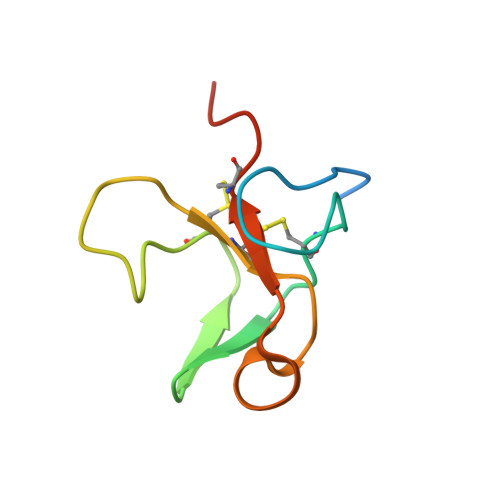Gelatin-binding region of human matrix metalloproteinase-2: solution structure, dynamics, and function of the COL-23 two-domain construct.
Briknarova, K., Gehrmann, M., Banyai, L., Tordai, H., Patthy, L., Llinas, M.(2001) J Biol Chem 276: 27613-27621
- PubMed: 11320090
- DOI: https://doi.org/10.1074/jbc.M101105200
- Primary Citation of Related Structures:
1J7M - PubMed Abstract:
Human matrix metalloproteinase-2 (MMP-2) contains an array of three fibronectin type II (FII) modules postulated to interact with gelatin (denatured collagen). Here, we verify that the NMR solution structure of the third FII repeat (COL-3) is similar to that of the second FII repeat (COL-2); characterize its ligand-binding properties; and derive dynamics properties and relative orientation in solution for the two domains of the COL-23 fragment, a construct comprising COL-2 and COL-3 in tandem, with each domain possessing a putative collagen-binding site. Interaction of the synthetic gelatin-like octadecapeptide (Pro-Pro-Gly)(6) (PPG6) with COL-3 is weaker than with COL-2. We found that a synthetic peptide comprising segment 33-42 (peptide 33-42) from the MMP-2 prodomain interacts with COL-3 and, albeit with lower affinity, with COL-2 in a way that mimics PPG6 binding. COL-3 strongly prefers peptide 33-42 over PPG6, which suggests that intramolecular interactions with the prodomain could modulate binding of pro-MMP-2 to its gelatin substrate. In COL-23, the two modules retain their structural individuality and tumble independently. Overall, the NMR data indicate that the relative orientation of the modules in COL-23 is not fixed in solution, that the modules do not interact with one another, and that COL-23 is rather flexible. The binding sites face opposite each other, and their responses to, and normalized affinities for, the longer ligand PPG12 are virtually identical to those of the individual domains for PPG6, thus precluding co- operativity, although they may interact simultaneously with multiple sites of the extracellular matrix.
Organizational Affiliation:
Department of Chemistry, Carnegie Mellon University, Pittsburgh, Pennsylvania 15213, USA.














